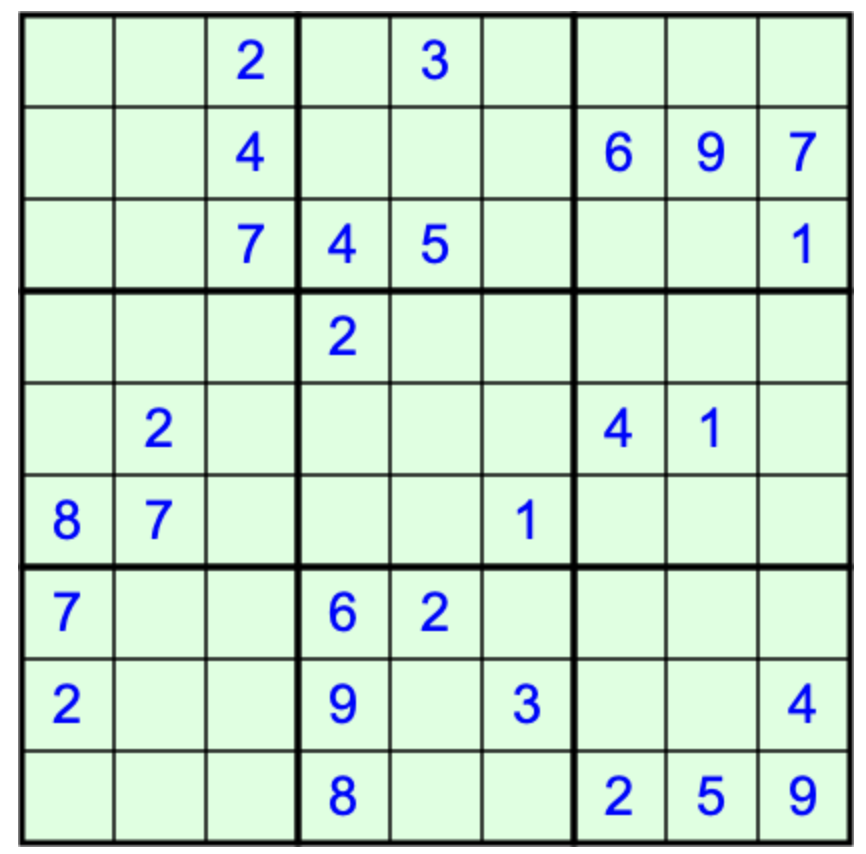Sudoku Variations
Classic Sudoku
 Sudoku is the logic puzzle popular around the world. The rules are simple, but the puzzles can be extremely challenging, making for a stimulating diversion. The objective is to fill a 9x9 grid with the digits 1-9 so that
Sudoku is the logic puzzle popular around the world. The rules are simple, but the puzzles can be extremely challenging, making for a stimulating diversion. The objective is to fill a 9x9 grid with the digits 1-9 so that
- Each row contains each of the digits 1-9 exactly once,
- Each column contains each of the digits 1-9 exactly once, and
- Each 3x3 subgrid contains each of the digits 1-9 exactly once.
One additional (and essential) property of every Sudoku puzzle is that there is a unique solution to the puzzle.

Sudoku-X

In a Sudoku-X puzzle, each of the main diagonals (from upper left to lower right and from lower left to upper right) must contain the digits 1-9 exactly once. These additional constraints can often be used to help find the solution to the puzzle.
The diagonal squares are shaded to indicate that you are playing Sudoku-X.
The "X" factor can be added to any of the puzzles described below, leading to several additional puzzle types, all of which will appear on my site.

Greater-than Sudoku
 In a Greater-than Sudoku puzzle, the objective is the same: Fill each square with a digit so that each row, column, and subgrid contains exactly one of each digit 1-9. However, the clues given follow a completely different pattern. None of the squares is prefilled with a digit. Instead, clues are given that represent relationships (less than or greater than) between adjacent squares. Logically following these clues will enable you to eliminate values from squares, eventually leading to a unique solution to the puzzle.
In a Greater-than Sudoku puzzle, the objective is the same: Fill each square with a digit so that each row, column, and subgrid contains exactly one of each digit 1-9. However, the clues given follow a completely different pattern. None of the squares is prefilled with a digit. Instead, clues are given that represent relationships (less than or greater than) between adjacent squares. Logically following these clues will enable you to eliminate values from squares, eventually leading to a unique solution to the puzzle.

Killer Sudoku
 Killer Sudoku introduces a little bit of arithmetic to a Sudoku puzzle, using the concept of a cage. A cage is a group of adjacent squares, enclosed within a dashed border. The following rules apply to cages:
Killer Sudoku introduces a little bit of arithmetic to a Sudoku puzzle, using the concept of a cage. A cage is a group of adjacent squares, enclosed within a dashed border. The following rules apply to cages:
- A cage cannot contain any duplicate entries.
- In the upper left hand corner of a cage is a numeric value. The sum of the digits in the cage must be equal to this value.

Greater-than Killer Sudoku
 As the name indicates, Greater-than Killer Sudoku combines some of the features of Killer Sudoku and Greater-than Sudoku puzzles:
As the name indicates, Greater-than Killer Sudoku combines some of the features of Killer Sudoku and Greater-than Sudoku puzzles:
- The puzzle contains cages, subject to the same rules that apply in Killer Sudoku.
- Less-than and greater-than symbols appear throughout the puzzle. However, instead of applying to the contents of individual squares, these constraints apply to the sums of values in the corresponding cages. "=" signs are also used to indicate that two adjacent cages contain equal sums.
- Because of the additional clues given by the less-than, greater-than, and equals constraints, some of the cage sums are missing. The player must use the constraints to deduce the cage sums in order to fill in the puzzle squares.
